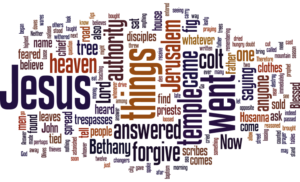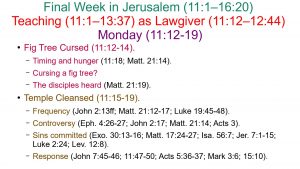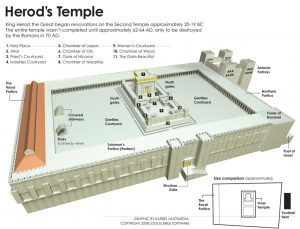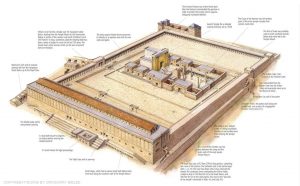Jesus’ Final Week in Jerusalem
Mark 11:1–16:20
Teaching (11:1–13:37)
King (11:1-11)
Lawgiver (11:12–12:44)
Monday (11:12-19).
Fig Tree Cursed (11:12-14).
Temple Cleansed (11:15-19).
How many times?
A controversial moment.
The sins committed.
 There are three actions mentioned here that Jesus was attempting to stop.
There are three actions mentioned here that Jesus was attempting to stop.Buying and selling in the temple (doves in particular).
Moneychanging.
Carrying wares through the temple.
When the Bible refers to the temple, it’s not always talking about the temple proper, but about what we call the temple complex.
Only priests were allowed in the temple, but anyone was allowed in the temple complex, up to a point.
 The Court of the Gentiles extended up to a dividing line by the temple proper.
The Court of the Gentiles extended up to a dividing line by the temple proper.The temple proper is the Second Temple, built by Ezra and Zerubbabel.
Herod the Great, the same Herod who tried to kill Jesus as a baby, extended the temple courtyard.
The activities Jesus was condemning were taking place in the Court of the Gentiles.
Buying, selling, and moneychanging were necessary for temple activities.
Not everyone who was traveling could carry an animal with them all that way to offer as a sacrifice in the upcoming observance of the Passover.
So they purchased what they needed at the temple—this was perfectly normal.
Moneychanging, or foreign exchange, was also necessary. Everyone had to pay the temple tax—even Jesus did (Exo. 30:13-16; Matt. 17:24-27).
 But the tax had to have been paid in shekels, the Jewish currency. So the Roman money that many of them had on them to be exchanged for shekels.
But the tax had to have been paid in shekels, the Jewish currency. So the Roman money that many of them had on them to be exchanged for shekels.So why is Jesus flipping tables?
Jesus’ quoting Isaiah 56:7 suggests that it was the location that was the issue.
Conducting this business in the Court of the Gentiles would be a distraction to the Gentiles trying to worship.
This might also speak to the third issue Jesus had with what was going on (talk about later).
Jesus’ alluding to Jeremiah 7:11, however, suggests there was some thievery involved.
Perhaps the exchange rates were exploitative. This thought is certainly bolstered by the explicit mention of doves.
In our series on Leviticus, do you remember what doves were most often used for? Sacrifices of the poor—which included when Jesus’ mother Mary cleansed herself after giving birth to Him (Luke 2:24; Lev. 12:8).
So people like His mother were being exploited. I might start flipping some tables, too!
In the same context of Jeremiah, he writes of the destruction of the temple, something coming soon for this temple as well (Jer. 7:1-15). It certainly sounds like what will soon happen to them in about 40 years.
There is one more thing He prevented people from doing: carrying wares through the temple. What is this?
As you might, recall, the temple complex takes up a huge section of the city in the middle of town.
So many people were treating it as a shortcut to go from place to place, including carrying wares, or more literally objects, things, vessels, or goods. This was a concern in the Mishnah as well.
McGarvey comments that Jesus was not permitting them “to carry any sack, bag, jug, pail, basket, parcel or such like thing through the sacred enclosure” (582).
It was no doubt distracting to the Gentile worshipers as well, treating the area as common while the Gentiles were trying to be holy and focus on the Lord.
The reaction.
First, what do you suppose your reaction would be after seeing this sight?
The people’s reaction—they were astonished at His teaching.
This, of course, was a common occurrence, but now He certainly had their attention after flipping some tables.
Maybe many of the people recognized the injustices, but weren’t sure how to handle it. They were putting up with it because they didn’t see an alternative.
In any event, He certainly garnered more of a following in the temple, right under the nose of the elites.
The guards’ non-reaction—Marty Kessler notes an apparently strange omission. What about the temple guards? Why weren’t they called to deal with Jesus?
Maybe they, too, were astonished at His teachings and couldn’t bring themselves to stop Him or arrest Him. This had happened before (John 7:45-46).
The scribes’ and chief priests’ reactions—they feared Him because of the following He had amassed. They also sought to destroy Him.
Perhaps they had the best of intentions. After all, the Romans were known to violently stamp out insurrection, and others had arisen to foment such rebellion against Roman occupation (John 11:47-50; Acts 5:36-37).
But what’s more likely particularly in this context is that they were benefiting from the thievery and exploitation of the people Jesus just threw out of the temple complex.
He was a threat to their pocketbook and to their power, and they were envious of Him (15:10).
After all, all the way back in Mark 3:6 they began to hatch a plan to destroy Him with the Herodians.
Now is when their plans would be kicked into high gear, being fulfilled before the week was out.
But that evening, He returned to His lodging in Bethany.



